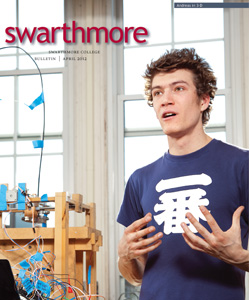Artist Without Borders
Nathan Florence ’94 trains an activist’s eye toward diverse communities and artistic media
Nathan Florence ’94, shown here with a recent painting of his wife Marian titled Full Flower, returned to his hometown of Salt Lake City (“this very bright blue dot in the middle of a very red state”) in 2001, when Marian got a job there.
When Nathan Florence ’94 arrived at Swarthmore from Utah, he planned to take premed courses. Yet he loved painting and wondered if pursuing art could be a realistic goal. As he pondered which path to take, he received some transformative advice from Stanford University psychologist Anne Jones Fernald ’65. She told him if he “put the same amount of work into anything [as one would into studying medicine],” he could be successful. Florence took that wisdom to heart, switched his major and has devoted his considerable energy to an artistic career.
Florence charted his distinctive course, pushing boundaries with a bit of the pioneer spirit that he was surrounded by growing up in Utah. Before graduating, he earned an Altman Award and Scholarship for Fine Arts Studies. When various postcollege fellowships did not pan out, he created his own artistic residency by traveling to Scotland and Italy. His trip was ultimately financed by the sale of many of the more than 100 paintings he produced during that year abroad.
Florence’s recent paintings have combined his interest in patterned textiles and paint. “I seal printed cotton with a matte medium, which gives the fabric a clear protection so you can still see the pattern coming through, but then I can paint right onto that like gesso,” he explains. “I figure out how the pattern of the cloth either conflicts with or enhances what I’m painting onto it. I try to go into it without overthinking it at the beginning, so the pattern is unpredictable.”
Florence’s subjects tend to be portraits, human figures and landscapes (see his work at www.nflorencefineart.com). By using the same pattern in different colors and shades, his recent paintings lend an almost ghostly tone to otherwise representational images.
“I definitely feel like my paintings are autobiographical,” he says, but that doesn’t exclude touches of whimsy and even surrealism. One of his largest paintings, for example, is called Let Us Go To and Build Us a Tower, a revisiting of the story of the Tower of Babel, which in this case, is built with luxury SUVs.
This kind of painting enables Florence’s activist side to come to the fore. “But I’ve also done a painting of myself as Don Quixote, because I feel like in some ways I’m tilting at windmills,” he says. “I’m wrestling with issues but then, in the end, I really haven’t made any difference in the world except I’ve done this painting, and maybe it’s a little cathartic.”
Florence also recognizes the powerful role that art plays in a home and is honored every time someone buys a painting. “If I can make a piece of art that can somehow resonate with someone else—that’s a pretty amazing thing!”
Despite his years of diligent work, Florence says “it took me forever to be OK with being an artist.” Perhaps partly in response to this feeling, Florence has found that his understanding of what constitutes art “has expanded to include a sense of community involvement, activism, and education. I’m really interested in education and the need for change in the way we think about teaching kids,” he explains. “It’s a much broader definition for me.”
In the last few years, Florence has helped start a charter school near Salt Lake City, the hometown to which he returned in 2001. The school’s name, the Weilenmann School of Discovery, suggests his primary interest. He drives his 7- and 9-year-old children to work with him every day. Florence also spent several summers teaching art in Calcutta for a charity affiliated with Mother Teresa’s organization—which he dubbed “art teachers without borders.”
Florence has now added filmmaker to his repertoire. At a panel discussion that revolved around a gay artist originally from Zimbabwe who had been a married Mormon, Florence was inspired by the atmosphere of support, tolerance, and unconditional love for this man in a room filled with a variety of people—Mormons, artists, gay activists, art enthusiasts. “Gay rights is one of the civil-rights issues of our time,” he says. Florence decided this story would make a compelling documentary, found someone to produce it for him and will soon be releasing a trailer with the working title Reconciliation: Art and Belief.
“Swarthmore was a very important catalyst in my way of thinking,” Florence says. “Again and again, I come back to Quaker roots and the pillars of community and tolerance. I have a tremendous respect for the Quaker tradition, and a lot of that has certainly informed where I’m going.”
 Email This Page
Email This Page